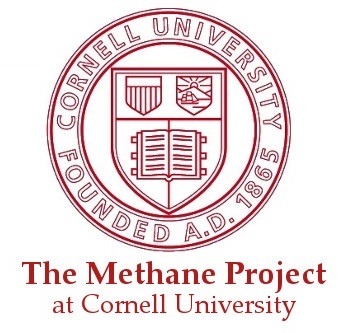
COP23 Press Event: Tuesday, 14 Nov, 2017, 16:00. Theatre of BULA Zone 3, Bonn, Germany
Robert Howarth, the David R. Atkinson Professor of Ecology
Is the global spike in methane emissions caused by the natural gas industry or animal agriculture? Reconciling the conflicting views.
Major Points:
- Methane is an important greenhouse gas and is currently responsible for an amount of global warming equal to approximately 60% of that caused by carbon dioxide. Methane reductions offer one of the few available approaches to immediately slow the rate of global warming, since the climate responds more quickly to decreases in methane compared to carbon dioxide.
- A very recent paper published in the journal Nature(1) uses the C14 radioactive carbon content of methane in ice-core bubbles to conclude that natural seeps of methane from ancient sources, (i.e. formed millions of years ago) are much smaller than previously thought. This implies that anthropogenic (fossil fuel) emissions of methane in recent decades must be proportionally higher than previously thought. The C14 content of atmospheric methane in the late 20th century indicated that 30% of all methane emissions (natural and human-caused) were from ancient sources; thus, if the natural seep emissions have been overestimated(1), the fossil-fuel emissions have been underestimated by an equal amount.
- With the upward revision of fossil-fuel sources required by the recent natural seep data(1), our estimates for the global methane budget suggest that half of all human-caused methane emissions in the late 20th century came from fossil fuel use, with the other half coming from animal agriculture, rice agriculture, sewage treatment plants, landfills, and biomass burning combined.
- Methane emissions and atmospheric concentrations were steady for a decade at the end of the 20th Century through 2005 or so but have been rising rapidly ever since that time. Human-caused methane emissions are now 6% greater than in 2000, an increased flux of 20 Tg per year.
- Using satellite data, two recent papers(2,3) concluded that the increase in methane emissions globally over the past decade was due largely to an increased source in the United States. This coincides with the explosion in shale gas and shale oil development in the United States, which may well be the cause of increased methane emissions globally(2). No other major changes in the US economy appear likely to have resulted in changes in methane emissions over this time.
- Methane emissions estimated from the satellite data are within the range of those measured by other integrative, top-down approaches, but are higher than estimates from additive, bottom-up studies upon which the US EPA relies. Some of these bottom-up studies have recently been called into question because of systematic methodological problems with instrument calibration. A formal investigation by the Inspector General of the US EPA is now underway to examine this.
- Several high visibility papers published in 2016 used the C13 stable carbon isotopic composition of atmospheric methane to infer what is driving changes in methane emissions over time. Two of these, published in Science(4) and Nature(5) concluded that increased methane emissions over the past decade were likely caused by animal agriculture, particularly emissions from cows and cattle. However, this conclusion is inconsistent with the satellite data, since the numbers of cows and cattle in the United States (the source of increased emission over the past decade) have been steady or declining in recent decades.
- One potential problem with the studies based on C13 in atmospheric methane is their failure to explicitly consider shale gas separately from conventional natural gas. A recent review of several studies(6) indicates that shale gas methane may tend to have a C13 signal that is significantly more negative than that for conventional natural gas: the shale gas signature in fact overlaps with the signature for cows and cattle. This means the shift in atmospheric methane C13 that was attributed to cows(4,5) may in fact have been from shale gas emissions (see Box 1).
- From the best evidence currently available, we tentatively conclude that the global increase in methane over the last decade is due to shale gas and shale oil development in the United States. A revised global methane budget for the year 2015 based on this finding shows that methane emissions from the oil and gas industry are now likely more than 2-times larger than those from all animal agriculture globally (see Box 2).
- If emissions from shale gas and oil are indeed the source of the increased global methane fluxes, this should have resulted in a measurable change in the C14 radiocarbon content of atmospheric methane. We suggest that this radiocarbon signal is a better and less ambiguous tracer to unravel whether fossil fuel emissions or biogenic emissions such as those from cows are the primary driver of change over the past decade.
We call for an urgent program to measure the C14 content of methane in the current global atmosphere as the best way forward to unambiguously determine what has been driving the global increase in atmospheric methane.
Box 1
Box 2
Citations:
(1) Petrenko et al. 2017. Minimal geological methane emissions during the Younger Dryas–Preboreal abrupt warming event. Nature 548: 443–446.
(2) Schneising et. al 2014. Remote sensing of fugitive methane emissions from oil and gas production in North American tight geologic formations. Earth’s Future 2: 548-558.
(3) Turner et al. 2016. A large increase in U.S. methane emissions over the past decade inferred from satellite data and surface observations. Geophysical Research Letters 43(5): 2218-2224.
(4) Schaefer et al. 2016. A 21st century shift from fossil-fuel to biogenic methane emissions indicated by 13CH4. Science 352(6281): 80-84.
(5) Schwietzke et al. 2016. Upward revision of global fossil fuel methane emissions based on isotopic database. Nature 538: 88-91.
(6) Golding et al. 2013. Stable isotope geochemistry of coal bed and shale gas and related production waters: A review. International Journal of Coal Geology 120: 24-40.

